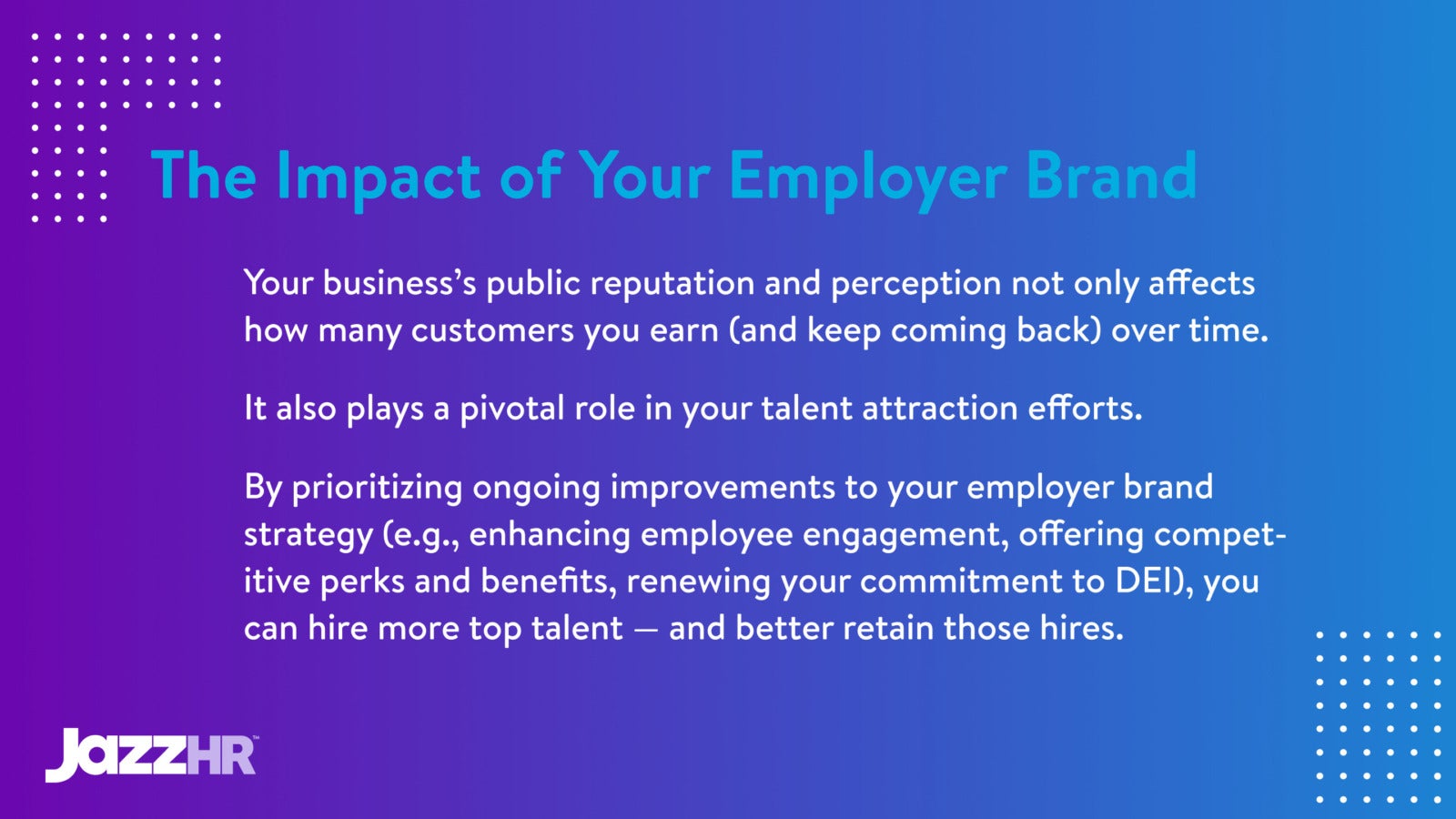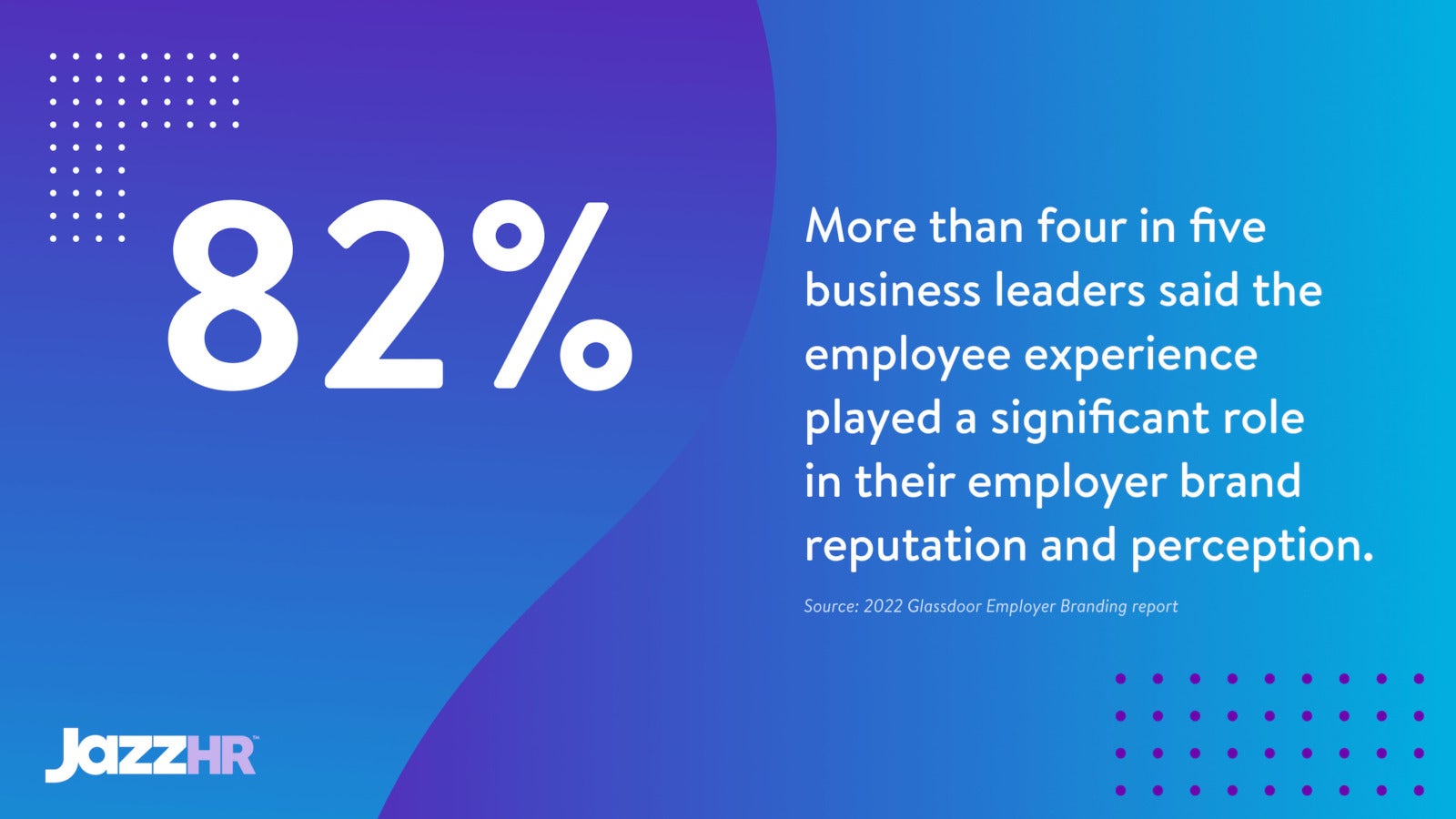A major roadblock that deters qualified candidates from glancing at your small business’s career page and open roles is a poor employer brand strategy — one that negatively impacts your company’s reputation.
Public forums such as Glassdoor, Indeed, and the like allow current and former employees as well as previously engaged talent your interviewed to post about their experience with your organization.
Some comments may signal you have a strong employer brand. (For instance, when past employees rave about your corporate culture or work-life balance.) Other feedback, though, may suggest you have work to do to improve your employer branding and better attract and retain top talent.
It’s the latter responses, in particular, your CEO and CHRO can use to revisit your employer value proposition (EVP) and develop a new employer branding strategy that helps you better position your business as one your entire workforce enjoys — and potential job candidates would enjoy too.
What is an employer brand? (And what does “good” employer branding look like for companies today?)
An employer brand refers to the way orgs of all kinds differentiate themselves from competitors in the market for candidates and employees.
- What is your company’s reputation among your workers?
- How is your business perceived as a place to work?
- Do all of your employees feel cared for and heard?
- Would they recommend you to their friends?
These are all important questions that contribute to your employer brand.
Per LinkedIn research, more than three-quarters of people seeking jobs look into the company’s employer brand before applying. This means that most of the candidates you interact with will already have an image of your company, especially those job seekers who have options when it comes to seeking new roles.
They’re also likely to leave a review after interviewing or interacting with your company during the hiring process. How does your online presence impact business? Well, there are three specific ways:
1) It impacts the quality and quantity of applicants
Positive reviews will draw applicants to your business, simplifying your hiring efforts and helping to attract top talent and build a more robust talent pool. Negative reviews will do the opposite: drive away candidates who are seeking better job opportunities and work environments.
2) It influences customer perception
Prospective customers are also looking at your online presence to assess company values. So while a positive online brand will encourage customer loyalty, negative reviews will likely disrupt their trust in your company.
3) It affects current and future employee satisfaction
Even if a current employee has a mostly positive outlook on their experience, those negative reviews or discussions about them in the workplace can be detrimental to productivity, focus, and retention.
Negative impressions of how you hire job seekers (i.e., a poorly structured TA process) can lower work performance by up to 30%. So, the quicker any issues tied to your SMB’s recruiting and hiring approach are addressed and remedied, the better it is for your employer brand perception.
Building an employer brand to boost your employee retention rate
A well-developed employer brand makes current employees proud of their positions and the company they work for. And it makes them more likely to refer others in their network towards open positions in your company. But, did you know that your employer brand can also support your bottom line?
It’s simple:
- Devoting resources to your brand and its maintenance (i.e., actively managing your employer brand and taking proactive measures to improve it, like addressing negative posts tied to your business on social media or career communities) can reduce costs elsewhere.
Companies that have stellar employer brand images don’t have to spend as much on recruiting costs because they don’t have to recruit as hard. When your employees love their job, they’re telling people about it. Or, at the very least, not running your good name down in an after-work rant.
This also means employee retention is likely improve, since your strongest employees are more likely to stay for the long run. Current employees act as ambassadors if they’re proud of where they work.
Understanding your employer brand’s role in talent attraction
In terms of attracting net-new talent, too many recruiters and employers treat the hiring process as a one-way street, requiring prompt answers and updates from candidates without offering the same thing in return.
Solutions like candidate texting and automated intelligent messaging make providing candidates with real-time, helpful feedback easier.
- Communicating hiring process steps to job seekers and relaying when their application has been received and reviewed leaves fewer unanswered questions and room for competition to sneak in. (In other words? This facet of your employer brand greatly affects candidate experience and conversion.)
Hand-in-hand with keeping candidates in the loop amid the recruiting process, a key part of your employer branding strategy is simply letting candidates know what to expect if they are hired. Offer them a clear and detailed glimpse of their new role’s duties and your company’s approach to work.
Nearly 90% of job seekers said they believe that good company culture and work environment is essential to business success. Demonstrate what makes your SMB stand out in this regard.
Action items to improve your employer brand strategy (and converting more qualified candidates)
You now know the importance of prioritizing ongoing enhancements to your employer brand.
Whether you’ve already allocated plenty of time and resources to boosting your EVP or need to start your employer branding strategy from scratch, there are a few key tasks you should tackle in the weeks and months ahead to start making headway in how your company is perceived publicly:
- Ensure your job descriptions and postings clearly explain both the open roles in question (desired impact, daily responsibilities, preferred experience) and your company’s mission, culture, and efforts around improving DEI and employees’ mental well-being.
- Assess each step and stage of your standard SMB recruiting process to ensure every hiring team member understands their distinct role in your TA efforts and knows how to conduct structured interviews that lead to stellar recruitment experiences for candidates.
- Ensure your have a powerful yet easy-to-use applicant tracking system in place that helps automate many key recruiting tasks (e.g., approval workflows, nurture campaigns, candidate feedback notifications) and eliminates a lot of manual TA labor.
Tackle these initial action items first, and you’ll be on your way to getting more active job seekers and passive prospects in your talent pool and engaging these individuals for open roles company-wide.
Find out how you can better source, nurture, and convert high-quality candidates with JazzHR’s leading applicant tracking system for small businesses like yours. Book your one-on-one demo today.








